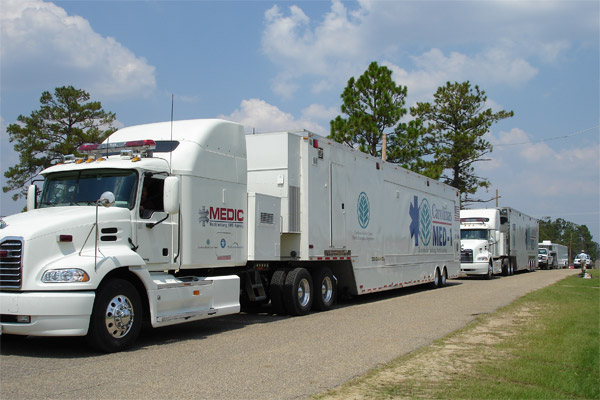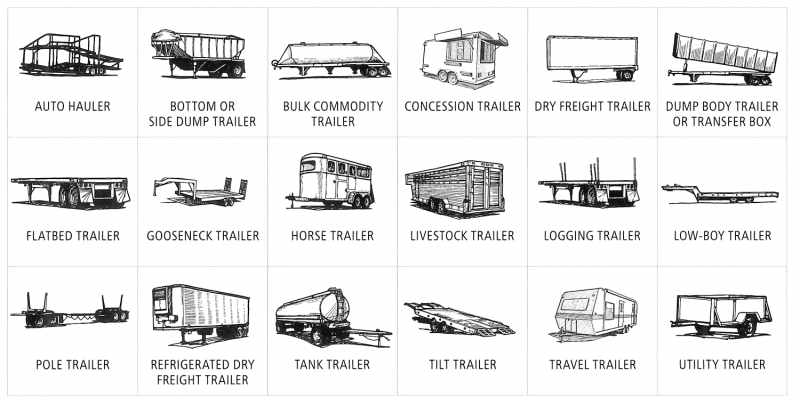
There are numerous styles out there and knowing the type of trailers needed in hauling the freight is a must in this industry! There are flatbeds, step decks, RGN’s and lowboys, double drops, conestoga’s, Vans and reefers. I know that I have left several out but these are the most commonly used.
Flatbeds– Also known as floats. The flatbed lengths come in 53′, 48′ 45′, 40′ and 24′. The most common out there is your 48′. The 53′ trailers are becoming popular but statistics would prove there to be more of the 48′ on the road. The widths of the trailers usually run about 102″ wide. However, you might run in to a trailer that is only 96″. It is very important that you know the dimensions of the commodity before setting up the driver for the load. The last thing you need is a truck order not used, an angry driver and an upset customer because you did not send in the correct trailer to handle the dimensions and weight. The height of a flatbed is generally 60″ off the ground. Most flatbeds can scale 48,000 pounds and some can scale a little more and some a little less. It just depends on how much their truck and trailer weigh.
Flatbeds with a side kit: This is when a driver or owner will take their standard flatbed and put a “side kit” on it. Most common kits have 4′ sides and then there are bows that attach from one side to the other allowing them to put a tarp over the top. This type of trailer is used for hauling your smaller commodity. The inside heights are usually 6′ at center of the bows and usually only 4′ on the sides. Be careful once again with height on this. KNOW YOUR COMMODITY AND THE DIMENSIONS! They can scale the same as the regular flatbed depending on weight of truck and trailer.

Step Deck: A step deck is similar to a flatbed however, it has a drop in the trailer to allow for taller freight. Most of your steps are either 53′ 51 and 48′ in length. There is usually 10′-11′ on the top deck and then it drops down about 24″ with the rest of the deck on 53′ trailer coming in around 42′ to 43′ and on a 48′ step they come in at 37′ to 38′. The width is the same as a flatbed, usually 102″. Step decks usually cannot scale as much weight as a flatbed, usually about 42,000 to 44,000 pounds.
RGN or Removable Goose Neck: The RGN is is used for loading larger machinery or over-sized cargo. The trailer mechanically works in the front of the gooseneck which retracts down in to a ramp. Now we have a ramp on the ground to drive your machinery up in to the well. The RGN usually has 29′ in the well unless it is extendable. The legal dimensions are usually 12′ high and the legal width of 8’6″. Extensions and a booster on the back can be added so they can insert their extendable making their well larger, known as a stretch RGN. It can stretch out to whatever you need in the well. I cannot stress enough how important it is to know what you are hauling and to have the correct dimensions. You will need accurate dimensions for the permits anyway. Many problems can arise from sending in a 6 axle RGN for an 88,000 pound excavator. It will not be able to handle the weight causing you a truck order not used, the cost of incorrect permits and could cost you a customer and a carrier in the long run while you try to recover that load. Money is time and time is money while it just sits there waiting for the correct size RGN to come in. Always go after that fall off load too. That is the detachable pieces that follow since permits only allow the one piece of equipment permitted. It is good to run the RGN and the fall off closely together so no confusion comes in to play and the receiver can immediately attach the pieces back together.
Lowboy: The lowboy trailers are slowly being replaced by the removable gooseneck due to their limited functions. The lowboys are used for heavy equipment but do not have the removable goose neck capability or functions to retract down to ramps and having the the equipment driven up in to the well.
Double Drop: A double drop trailer is similar to an RGN however, it does not disconnect from the goose neck. It has a top deck of about 10′-11′ and drops down to 26′-29′ depending on the trailer, it then goes back up over the rear wheels for a smaller drck of around 8′-10′. This type of trailer is used to haul taller equipment that cannot be driven on. They are usually crane loaded.
Conestoga: A conestoga is basically a flatbed with retractable sides. The sides of the trailer will retract to the front. The sides are mounted on rails allowing for the retraction. It is not often that a driver will take his sides down accommodate your flatbed freight. They are handy if you are moving freight that needs to be tarped. Watch out on the height because the inside height might only be 96″-99″ depending on the trailer.
Power Only: A power only or also known as a tow away is exactly how it sounds. It’s a truck without a trailer and the driver just hooks on to a trailer and takes it to the destination. We use tow aways for the movement of van and pole trailers in the pipeline industry. Make sure in what you are needing moved does or does not require a pintle hook. Your construction trailers needing to be moved will require the tow away to have a pintle hook and there are ball hook ups, and fifth wheels. We will go over that in our upcoming video.
Van: A van trailer is probably the most common type of trailer. They are usually 48′ to 53′ long. Their width is still about 102″ and their inside height be the same. It is important to know if it has a “swing door” or a “roll door”. If it has a roll door you might not be able to get your product through the opening and would need a swing door. Vans are made for palletized freight. The deminisions of a standard pallet is 48″x48″x48″ allowing the shipper to put two side by side and two high with a little extra room to spare. Vans can usually scale up to 44,000 pounds.
Reefer: A reefer is similar to a van but is insulated and has a cooling unit attached to the front of the trailer. This allows for carrying freight that needs to be kept at a constant temperature. The dimensions are the same as a van except for the inside and they are usually about 99″-100″ wide due to the insulation they put in the walls to keep the specific temperature needed for your commodity.
I hope that you can use this as a reference. A good broker/logistics coordinator will always know the specifications of the product they are having moved and the type of trailer it goes on.
